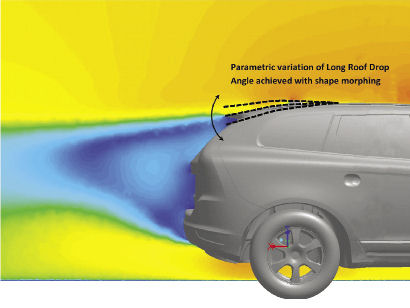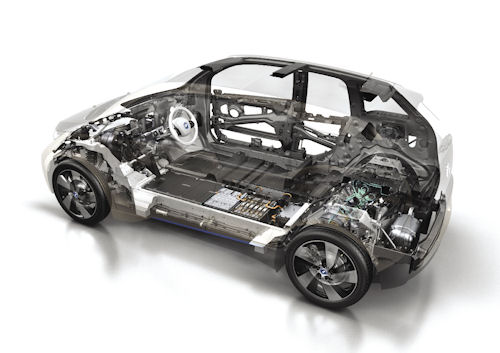Latest News
September 1, 2013
When new fuel efficiency regulations were finalized last year, the clock started ticking for automakers and their suppliers to increase fuel economy to the equivalent of 54.5 mpg for cars and light-duty trucks. That’s nearly double what new cars and trucks get today.
But this is a marathon, not a sprint. The final deadline to meet the new standards isn’t until 2025. And the 54.5 mpg target isn’t what you’ll see in every vehicle you buy in 12 years. As its name implies, the Corporate Average Fuel Economy (CAFE) is an average of automakers’ fleets of vehicles, and the fuel economy is measured in a lab, which always returns more efficient results than the real world. On top of that, the targets can shift based on automakers’ production tallies to allow them to produce the types of vehicles that people want to buy.
Advancing Engineering
Even with those caveats, the new rules are expected to lead to significant investments in technology to make vehicles lighter, more efficient, and more aerodynamic.
The National Highway and Traffic Safety Administration (NHTSA) and the U.S. Environmental Protection Agency (EPA) “expect automakers to use a range of efficient and advanced technologies to transform the vehicle fleet,” according to an NHTSA press release on the regulations.
 The aerodynamics of a car design. Image courtesy of ANSYS Inc. Geometry courtesy of Volvo Cars Corp. |
“I think that the automakers are very serious about CAFE standards,” says Sandeep Sovani, Ph.D., ANSYS’ director for Global Automotive Industry. “A significant amount of effort and research and development is being placed in fuel economy and emission standards—probably the majority of R&D.”
On the other hand, Sovani says, it’s “not a challenge they cannot solve. It’s not that they are terribly anxious about it. I think the government chose this number and timing, 2025, widely because it is a challenge, but not one that cannot be met.”
MSC’s senior manager of simulation services, Derek Barkey, agrees with Sovani’s sentiment. Barkey oversees a team of engineers who work with MSC customers to improve those customers’ products via simulation and optimization.
“In general, automakers are pretty confident they can meet the requirements,” Barkey says. “The concern is meeting the standards and still have a cost-effective vehicle for customers.”
Take the new BMW i3 as an example. With zero emissions, it exceeds emission standards. But with a sticker price of $41,350, it doesn’t meet that many consumers’ purchasing standards.
Both Barkey and Sovani present the BMW i3 as an example of how designing a fuel-efficient vehicle can effect every part of the design—from its carbon-fiber reinforced plastic passenger compartment and plastic outer skin to its aluminum drive module, which houses all the drive and chassis technology.
“It’s a very lightweight electric car,” says Barkey. “Having improved aerodynamics and improved materials not only makes more fuel efficient, but helps with aesthetics. It also helps improve maintenance, since composites are dent- and corrosion-resistant.”
On the flip side, no one expects the auto industry as a whole to make drastic design changes to their lineups the way BMW has with its i3. Rather, one optimization will likely lead to advances in other areas of the vehicle.
 The BMW i3 shows how fuel efficiency can influence every aspect of an automobile’s design. Image courtesy of BMW. |
“There will be lots of small innovations,” says Barkey. “We see a lot of those happening already. Look at Tesla’s aerodynamics, even the way they do the door handle. That’s been helped a lot by CAE. Lots of these small, incremental improvements will allow automakers to reach the goal for the CAFE standard.”
Sovani says he expects engines to be downsized and turbocharged, combustion strategies to be revisited, transmissions to be tuned for fuel efficiency, aerodynamics to be improved via new materials, and weight to be optimized for every part in the vehicle, from seat mounts to structural geometry.
“There will even be cool new inventions, like shutters for the front grill that are rotated by motors to adjust the angle, based on the amount of airflow needed by the engine,” he predicts. “Other technologies will focus on recovering waste heat from the exhaust system by using the thermoelectric effect.”
Experts in Demand
| Simulation’s Evolution Sandeep Sovani, Ph.D., ANSYS’ director for Global Automotive Industry, says simulation’s progress in the auto industry can be tied to decades of advancements:
“Eventually,” he adds, “the vehicle will be simulated as one entire system where the whole model is constructed as designed. That’s what I think will be the simulation advancement of next decade, including simulating the software of the vehicle as part of the system.” |
While ideas for more fuel-efficient vehicles are a dime a dozen, the expertise needed to make them reality is in shorter supply. That could spell opportunity for engineering service providers.
“One challenge comes when you start moving away from legacy processes and materials,” says Barkey. “Automakers understand well how steel behaves, how to protect it from corrosion, what thickness is needed to avoid warranty issues A lot of that is based on rules of thumb and legacy knowledge. When that’s not there, they can run into long-term problems for the vehicle.”
Sovani agrees there is a dearth of fuel economy development expertise, but he says automakers will try to add to their in-house teams before looking for outside help.
“Companies are fighting to gain control of that expertise,” he says. “Companies are hiring simulation and development engineers to get the expertise. They’re doing the work in-house as much as possible to give them a strategic advantage.”
Barkey says, in his experience, there are two things clients need most from software developers and engineering service providers right now: an understanding of alternative materials, such as composites, and some help managing the large amounts of CAE data being produced.
“When you generate all the simulations needed to evaluate new design concepts, just keeping track of which have been evaluated—which are best for one thing or another—is a challenge,” he says. “You might lose track of the data and just have the model, but not know why it’s better than another.”
Giving Innovation a Push
While it remains to be seen whether the new fuel economy standards will “encourage investment in clean, innovative technologies that will benefit families” like the NHTSA press release claims, Barkey does say he expects them to hasten the inevitable.
“Automakers’ interest in improving design has always been there,” he says. “It’s why we don’t still put wood in cars as a structural material. CAFE is focusing that innovation.”
In previous decades, he says, innovations focused on safety, such as crumple zones and airbags. Those innovations were also encouraged by regulations, but likely would have happened anyway because safety is important to customers, says Barkey.
“CAFE accelerates the pace and focuses innovation on the use of CAE and simulation to aid in the development of cars,” he concludes. “It was going to happen anyway because using simulation makes sense—it keeps costs down, and ensures materials are used efficiently.”
Jamie Gooch is managing editor of Desktop Engineering. Contact him via [email protected].
More Info
Subscribe to our FREE magazine, FREE email newsletters or both!
Latest News
About the Author
Jamie Gooch is the former editorial director of Digital Engineering.
Follow DE





